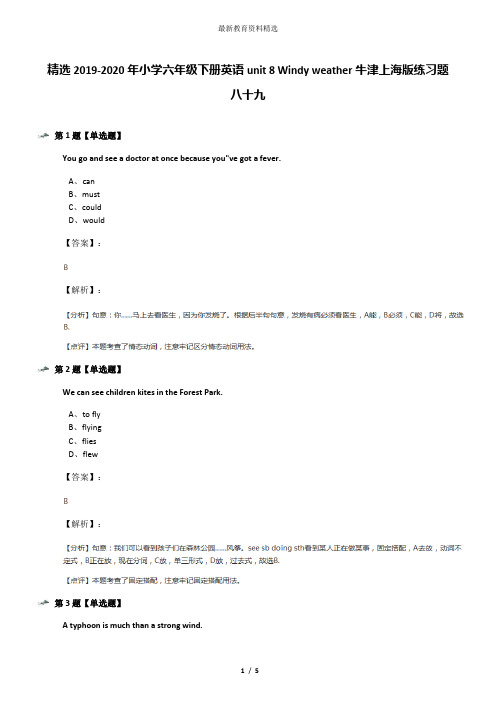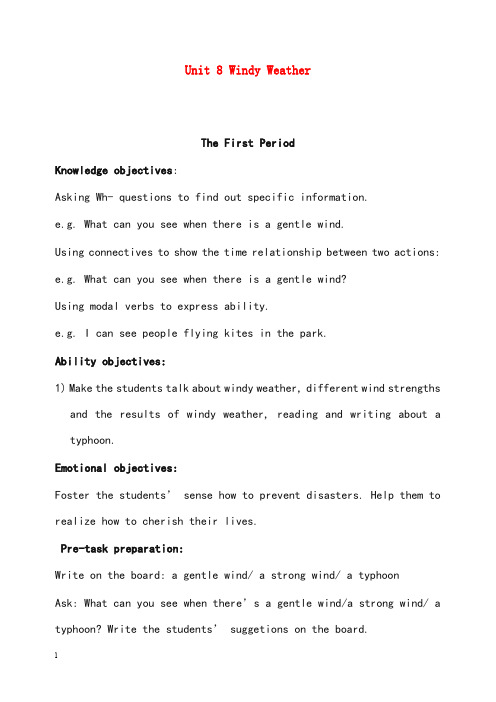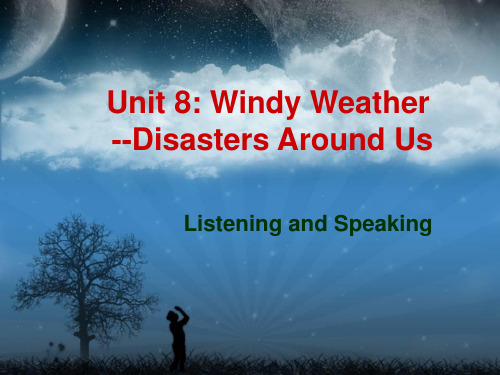牛津上海版六年级英语下册unit 8 windy weather 教学课件
- 格式:ppt
- 大小:5.88 MB
- 文档页数:67

精选2019-2020年小学六年级下册英语unit 8 Windy weather牛津上海版练习题八十九第1题【单选题】You go and see a doctor at once because you"ve got a fever.A、canB、mustC、couldD、would【答案】:【解析】:第2题【单选题】We can see children kites in the Forest Park.A、to flyB、flyingC、fliesD、flew【答案】:【解析】:第3题【单选题】A typhoon is much than a strong wind.A、strongB、strongerC、strongestD、the strongest【答案】:【解析】:第4题【单选题】When there is a typhoon, the wind will become .A、stronglyB、strongC、slightD、slightly【答案】:【解析】:第5题【单选题】Ships should stay typhoon shelters because a typhoon may sink them if they are the typhoon shelters.A、at, inB、in, outC、in, outsideD、outside, outside【答案】:【解析】:第6题【单选题】We can bees flying around in spring.A、lookB、hearC、seeD、listen【答案】:【解析】:第7题【单选题】When a typhoon comes, we close the windows.A、needn"tB、shouldn"tC、mayD、should【答案】:【解析】:第8题【单选题】— I"m sorry for being late. I wanted to be here earlier, but the traffic was too heavy. —A、Glad to hear that.B、That"s right.C、Thank you all the time.D、Never mind.【答案】:【解析】:第9题【单词拼写(词汇运用)】Fishing boats should stay in typhoon s______.【答案】:【解析】:第10题【单词拼写(词汇运用)】The students help Miss Wang make a d______board.【答案】:【解析】:第11题【语法填空】Tom is a______boy, and he always does his homework______(careful). 【答案】:【解析】:第12题【语法填空】The wind now is becoming much______(gentle). 【答案】:【解析】:第13题【语法填空】What about going______on such a fine day? (fish) 【答案】:【解析】:。


牛津英语上海版六年级下册知识点整理Module1 City lifeUnit1 Great cities in Asian词组:the capital of... ...的首都 north-east东北 from...to...从...到...in the past在过去 the Great Wall长城 more than=over超过eat dumpling吃饺子 tall buildings高楼大厦huge department stores大型的百货商店 a lot of许多语法点:1.Beijing is north of Shanghai.北京在上海的北部。
(1)两地不相邻:A is north of B.(2)所属关系:A is in the north of B.(3)两地接壤:A is on the north of B.2.How far is it from Shanghai to Beijing?从北京到上海有多远?How far... 多远。
询问距离的远近,路程的长远。
3.How long does it take to travel from Shanghai to Beijing by train?坐火车从上海到北京要多久?(1)How long...多久。
询问时间长短。
How long…多长。
用于询物的问长度。
(2)by+交通工具,表示“乘...交通工具”,用How提问。
4.It takes about ten hours.大约需要十小时It takes (sb.) st. to do sth. 做某事需要花费多长时间。
5.They enjoy eating dumplings.他们喜欢吃饺子enjoy/like/love doing sth. 喜欢做某事6.Two and a half days=Two days and a half两天半Half an hour=one and a half hours=one/an hour and a half一个半小时Unit2 At the airport词组:plane ticket机票 silk scarf丝巾 a lot of/plenty of大量的,许多departure time出发时间 leave for出发去某地 have to不得不be going to将要 arrive at到达boarding card登机牌 name tap姓名语法点:1.Aunt Judy and Uncle Mike have lived in Los Angeles for six years.朱迪婶婶和迈克叔叔在洛杉矶已住了六年。

Unit 8 Windy WeatherThe First PeriodKnowledge objectives:Asking Wh- questions to find out specific information.e.g. What can you see when there is a gentle wind.Using connectives to show the time relationship between two actions: e.g. What can you see when there is a gentle wind?Using modal verbs to express ability.e.g. I can see people flying kites in the park.Ability objectives:1)Make the students talk about windy weather, different wind strengthsand the results of windy weather, reading and writing about a typhoon.Emotional objectives:Foster the students’ sense how to prevent disasters. Help them to realize how to cherish their lives.Pre-task preparation:Write on the board: a gentle wind/ a strong wind/ a typhoonAsk: What can you see when there’s a gentle wind/a strong wind/ a typhoon? Write the students’ suggetions on the board.While-task procedure1.Play the cassette for the dialogue. The students listen and repeatwith their books closed.2.Select pairs to say the dialogue.3.In pairs, students match the pictures with the winds.Ask: Which pictures show a gentle wind/ a strong wind/ a typhoon?4.Ask questions:e.g. 1) What can you see in Picture 1?To elicit: I can see people holding raincoats tightly.Write the sentences on the board. Repeat the procedure for the other pictures:I can see leaves blowing slightly in parks.I can see flags flying in the sky.I can see people taking flower pots into their flats.I can see clouds moving quickly.I can see people windsurfing on the sea.5. In pairs, students ask and answer questions about the pictures. Consolidation:a)Give the students tine to look at the pictures.b)Play the recording. The students listen and write.c)Play the recording again . Check the answers.The second periodKnowledge objectives:Asking wh-questions to find out specific informatione.g. What can you see when there is a gentle wind?Using connectives to show the time relationship between two actions.e.g. We can see…when there…Using model verbs to talk about ability.Ability objectives:Make the students talk about different wind strengths and results of windy weather.Emotional objectives:Foster the students sense how to prevent disasters. Help them to realize how to cherish their lifePre-task preparation:Ask: Is it windy today? What can you see?While-task procedure:1.Read Think and say. In pairs, students practise the dialogues. Askpairs to say one of their dialogues.2.Read Find and write. If the students have brought pictures of windyweather, they can stick them in the panels. Or they can draw pictures.3.The students write the captions . Select individual students to readout a caption.Post-task activitiesWorkbook 6B page 53a.In pairs, students talk about what they can see and what theycan/should do in different kinds of windy weather.b.Give the students time to draw and write sentences.c.Select individual students to read out their answers. ConsolidationWorkbook 6B page 48The Third PeriodKnowledge objectives:Using the simple past tense to talk about past states and events.e.g. Kitty and Ben were in the park.Using adverbs to describe manner.e.g. They flew their kite happily.Ability objectivesLet the students read and write about the typhoon.Emotional objectives:Foster the students’ sense how to prevent disasters. Help them to realize how to cherish their lives.Pre-task preparation.Ask: What happens in a typhoon?While-task procedure.1.Play the cassette for Look and Learn. The students repeat:Ask: What happened to trees/ boats in a typhoon?Who cleaned the street after the typhoon?2.Give the students time to read the story silently.3.Play the cassette. The students follow in their books.4.Ask the students to read the story.5.Write the simple past forms of the verbs on the board:are-were, fly-flew, blow-blew, move-moved, become-became, go-went,watch-watched, fall-fell, sink-sank, passed-passed, walk-walked; see-sawAsk questions about the storyWorkbook 6B page 52.ConsolidationWorkbook 6B page 47The Fourth PeriodKnowledge objectives:Using modal verbs to express obligatione.g. We should stay indoors.Ability objectives:Let the students make a poster of Typhoon.Emotional objectives:Foster the students’ sense how to prevent disasters. Help them to realize how to cherish their life.Pre-task preparation:1.Think and say.What can you see when there is a typhoon?Encourage the students to give as many answers as possible.2.Look and learnTyphoon, shelter,3.Read, think and writeWith your classmates, look at the pictures on the poster. Write some safety rules.4.When a Typhoon is coming.5.Look, think and say. When a Typhpoon is coming. ConsolidationWorkbook 6B page 50。


年级:六年级辅导科目:英语课时数:3课题6B Unit8基础知识梳理教学目的1.使学生能够基本掌握Unit8中的基础词汇词组并且能够进行一些词汇变形练习;2.帮助学生梳理重点句型和语言点。
教学内容Step1: Greetings & Free talkHow are you today? Is there somethinginteresting or important this week?What have you learned in your school? (询问学校课程进度)Step2: Lead in—学海拾贝Early birds catch the worms.勤能补拙。
Step3: Words and expressions.Ⅰ. Words.1. display n.展示;陈列e. g. On New Year's Eve, the display of fireworks was really beautiful. 除夕之夜的焰火确实很漂亮。
There will be a clothing display next Sunday.下周日将有一个服装展示。
【记忆链接】on display正在展览中(=on show):e. g. The work was on display.这个作品正在展出。
2. gentle adj.温和的e. g. She is a gentle and kind girl.她是一个温柔和蔼的女孩。
“May I help you?" she said with a gentle voice. “有什么可帮助的吗?”她用温和的声音说道。
3. hold v.抓住;拿住;抱住e. g. The girl is holding her father’s hand.那个女孩正抓住她父亲的手。
Julie held the cat in her arms.朱莉把小猫搂在怀里。
Unit3Weather 完整版课件一、教学内容本节课我们将学习教材《英语》第二册Unit 3 “Weather”的内容。
具体包括:Chapter 1 天气的词汇和表达方式;Chapter 2 句型和对话,询问和描述天气;Chapter 3 关于天气的短文阅读。
二、教学目标1. 知识目标:学生能够掌握描述天气的词汇和表达方式,如:sunny, cloudy, rainy, windy等;学会使用句型"What's the weather like?"来询问和描述天气。
2. 技能目标:通过小组合作,学生能够进行关于天气的对话,提高口语表达能力。
三、教学难点与重点重点:描述天气的词汇和句型,如:sunny, cloudy, rainy, windy等;句型"What's the weather like?"的运用。
难点:如何灵活运用所学词汇和句型进行对话和描述。
四、教具与学具准备1. 教具:PPT课件,天气预报视频,卡片。
2. 学具:学生用书,练习册,彩色笔。
五、教学过程1. 导入(5分钟)播放天气预报视频,引导学生关注天气变化。
学生分享自己所在城市的天气情况。
2. 新课内容展示(15分钟)Chapter 1:展示天气词汇,让学生跟读并模仿。
Chapter 2:展示句型和对话,让学生分角色朗读和表演。
Chapter 3:阅读短文,让学生了解不同城市的天气特点。
3. 实践情景引入(15分钟)分组讨论,让学生用所学词汇和句型描述自己所在城市的天气。
每组选代表进行汇报,其他同学评价。
4. 例题讲解(10分钟)出示范例,让学生学会如何描述天气。
讲解句型和语法要点。
5. 随堂练习(15分钟)学生完成练习册上关于天气的练习题。
老师及时反馈,解答学生疑问。
六、板书设计1. 天气词汇:sunny, cloudy, rainy, windy等。
2. 句型:What's the weather like?3. 对话示例:A: What's the weather like in Beijing? B: It's sunny and hot.七、作业设计1. 作业题目:描述自己所在城市的天气,不少于50词。